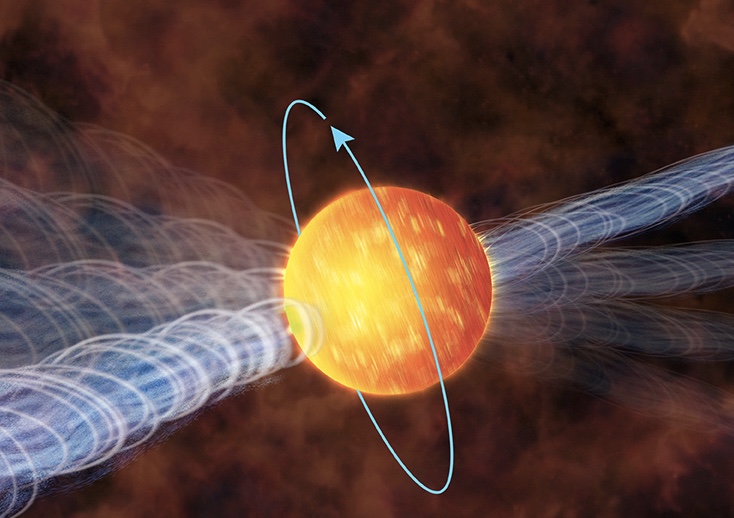NASA's Got a Plan for a 'Galactic Positioning System' to Save Astronauts Lost in Space

COLUMBUS, Ohio — Outer space glows with a bright fog of X-ray light, coming from everywhere at once. But peer carefully into that fog, and faint, regular blips become visible. These are millisecond pulsars, city-sized neutron stars rotating incredibly quickly, and firing X-rays into the universe with more regularity than even the most precise atomic clocks. And NASA wants to use them to navigate probes and crewed ships through deep space.
A telescope mounted on the International Space Station (ISS), the Neutron Star Interior Composition Explorer (NICER), has been used to develop a brand new technology with near-term, practical applications: a galactic positioning system, NASA scientist Zaven Arzoumanian told physicists Sunday (April 15) at the April meeting of the American Physical Society.[10 Futuristic Technologies 'Star Trek' Fans Would Love]
With this technology, "You could thread a needle to get into orbit around the moon of a disant planet instead of doing a flyby," Arzoumian told Live Science. A galactic positioning system could also provide "a fallback, so that if a crewed mission loses contact with the Earth, they'd still have navigation systems on board that are autonomous."
Right now, the kind of maneuvers that navigators would need to put a probe in orbit around distant moons are borderline impossible. In the vastness of outer space, it's just not possible to figure out a ship's location precisely enough to engine-firing just right. That's a big part of why so many of the most famous planetary missions NASA has managed — Voyager 1, Juno, and New Horizons among them — have been flybys, where spacecraft have flown close to, but just past, major planetary objects. [How the Voyager Space Probes Work (Infographic)]
Relying on Earth for navigation is also a problem for crewed missions, Arzoumian said. If that signal, connecting Earth and a distant spacecraft like a long and tenuous thread, gets somehow lost, astronauts would be hard-pressed to find their way home from Mars.
Here's how the galactic positioning system would work
A galactic positioning system would go a long way toward solving that problem, Arzoumian said, though he cautioned he's more a pulsar expert than a navigator. And it would work a great deal like the Global Positioning System (GPS) on your smartphone.
When your phone tries to determine its position in space, as Live Science has previously reported, it listens with its radio to the precise ticking of clock signals coming from a fleet of GPS satellites in Earth orbit. The phone's GPS then uses the differences between those ticks to figure out its distance from each satellite, and uses that information to triangulate its own location in space.
Get the world’s most fascinating discoveries delivered straight to your inbox.
Your phone's GPS works fast, but Arzoumian said the galactic positioning system would work slower —taking the time needed to traverse long stretches of deep space. It would be a small, swivel-mounted X-ray telescope, which would look a lot like the big, bulky NICER stripped down to its barest minimum components. One after another, it would point at at least four millisecond pulsars, timing their X-ray "ticks" like a GPS times the ticks of satellites. Three of those pulsars would tell the spacecraft its position in space, while the fourth would calibrate its internal clock to make sure it was measuring the others properly.
Arzoumian noted that the underlying concept behind the galactic positioning system isn't new. The famous Golden Record mounted on both Voyager spacecraft contained a pulsar map that points any aliens who one day encounter it back to planet Earth.
But this would be the first time humans have actually used pulsars to navigate. Already, Arzoumian said, his team has managed to user NICER to track the ISS through space.
NASA's Station Explorer for X-Ray Timing and Navigation (SEXTANT) program, the team behind the Galactic Positioning System, had the goal of tracking the ISS to within 6.2 miles (10 kilometers) over the course of two weeks, Arzoumian said.
"What the demonstration back in November achieved was more like 7 kilometers [4.3 miles] in two days," he said.
The next goal for the program is to track the station to within 1.9 miles (3 km) he said. He said that eventually the team hopes to get under 0.6 miles [1 kilometer] of precision.
"I think we can get beyond that, but I don't know how far," he said.
And that's all in low-Earth orbit, he said, with the station wheeling in wild, unpredictable circles and half the sky blocked out by a giant planet, covering different pulsars every 45 minutes. In deep space, with a functionally unlimited field of view and where things mostly move in predictable, straight lines, he said, the task will be much easier.
Already, Arzoumian said, other teams within NASA have expressed interest in building the galactic positioning system into their projects. He declined to say which, not wanting to speak for them. But it seems likely that we might see such a futuristic device in action in the very near future.
Originally published on Live Science.



